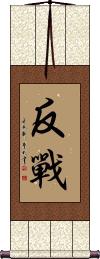Many custom options...
And formats...

Non-Violence in Chinese / Japanese...
Buy a Non-Violence calligraphy wall scroll here!
Personalize your custom “Non-Violence” project by clicking the button next to your favorite “Non-Violence” title below...
Non-Violence
非暴力 is fairly self-explanatory.
The first character means “not,” “non-,” or “un-”
The middle and last character together mean “violence,” “use of force,” or simply “violent.”
Together, these three characters would normally be translated as “nonviolence.” A great gift for your favorite peace-lover.
See Also: Peace
Antiwar / Anti-War
反戰 means antiwar, as in what a pacifist believes in.
China does plenty of saber-rattling but thankfully doesn't go to war very often, and Japan has embraced a pacifist ideology. Therefore, it's rare to need this word. However, this is the kind of word that war protesters would write on their signs.
![]() There is a modern Japanese version of the second character which has become the standard in Japan after WWII. If you want your calligraphy written in the modern Japanese form, please click on the Kanji shown to the right instead of the button above. Note: Most Japanese and all Chinese people will recognize the form shown in the upper left.
There is a modern Japanese version of the second character which has become the standard in Japan after WWII. If you want your calligraphy written in the modern Japanese form, please click on the Kanji shown to the right instead of the button above. Note: Most Japanese and all Chinese people will recognize the form shown in the upper left.
Not the results for non-violence that you were looking for?
Below are some entries from our dictionary that may match your non-violence search...
| Characters If shown, 2nd row is Simp. Chinese |
Pronunciation Romanization |
Simple Dictionary Definition |
非暴力 see styles |
fēi bào lì fei1 bao4 li4 fei pao li hibouryoku / hiboryoku ひぼうりょく |
More info & calligraphy: Non-Violence(noun - becomes adjective with の) nonviolence; non-violence |
不殺生 不杀生 see styles |
bù shā shēng bu4 sha1 sheng1 pu sha sheng fusesshou / fusessho ふせっしょう |
{Buddh} (See アヒンサー) ahimsa; abstinence from taking life; principle of non-violence in Jainism, Buddhism, Hinduism, etc. prāṇātipātād vairamaṇī (virati). The first commandment, Thou shalt not kill the living. |
アヒンサー see styles |
ahinsaa / ahinsa アヒンサー |
{Buddh} (See 不殺生) ahimsa; abstinence from taking life; principle of non-violence in Jainism, Buddhism, Hinduism, etc. |
Variations: |
ahinsaa; ahimusaa / ahinsa; ahimusa アヒンサー; アヒムサー |
{Buddh} (See 不殺生) ahimsa (principle of non-violence in Jainism, Buddhism, Hinduism, etc.) (san: ahimsā); abstinence from taking life |
The following table may be helpful for those studying Chinese or Japanese...
| Title | Characters | Romaji (Romanized Japanese) | Various forms of Romanized Chinese | |
| Non-Violence | 非暴力 | hibouryoku / hiboryoku | fēi bào lì fei1 bao4 li4 fei bao li feibaoli | fei pao li feipaoli |
| Antiwar Anti-War | 反戰 反战 / 反戦 | han sen / hansen | fǎn zhàn / fan3 zhan4 / fan zhan / fanzhan | fan chan / fanchan |
| In some entries above you will see that characters have different versions above and below a line. In these cases, the characters above the line are Traditional Chinese, while the ones below are Simplified Chinese. | ||||
Successful Chinese Character and Japanese Kanji calligraphy searches within the last few hours...





